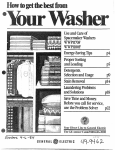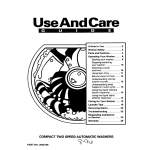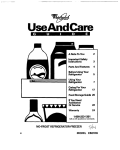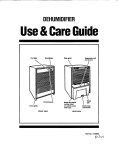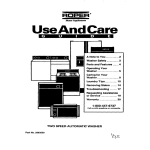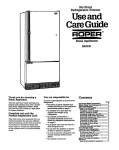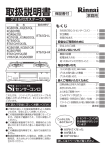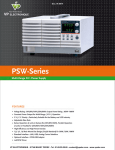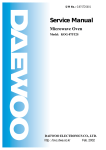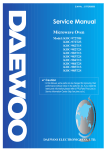Download UseAndCare - Whirlpool
Transcript
UseAndCare
A Note to You ......................... 2
Understanding Safety ......... M
Parts and Features of
Your Washer/Dryer.. ............... 6
Operating Your Washer ........ .7
Starting your washer.. ........ .7
Stoppingkestarting
your washer ........................ 8
Selecting a cycle
and time .............................. 8
Using Rinse and Spin ........ .9
Using Drain and Spin.. ........ 9
What happens in
each cycle.. ....................... 10
Adding liquid
chlorine bleach.. ................ 11
Adding liquid
fabric softener ................... 11
Operating Your Dryer.. ......... 12
Starting your dryer ............ 12
Stopping/restarting
your dryer .......................... 12
Selecting a cycle
and setting ........................ 12
Laundry Tips.. .......................
Caring tar Your
Washer/Dryer ........................
Troubleshooting ...................
Requesting Assistance
or Service.. ............................
Warranty ...............................
16
25
29
33
36
I-800-44-ROPER
Cd ~8 with quodona
AUTOMATIC WASHER/DRYER
PART NO. 3396314
or comments.
A Note to You
Thank
you for buying
a Ropee
appliance.
Roper appliances give you all the functionality of name brand appliances at a value price. To
ensure you enjoy years of trouble-free operation, we developed this Use and Care Guide. It
contains valuable information about how to operate and maintain your appliance properly and
safely. Please read it carefully. Also, please complete and mail the Ownership Registration
Card provided with your appliance. This card helps us notify you about any new information
on your appliance.
Please
record
your
model’s
information.
Whenever you call to request service on
your appliance, you need to know your
complete model number and serial number.
You can find this information on the model
and serial number plate (see diagram on
page 6 for location of label).
Please also record the purchase date of
your appliance and your dealer’s name,
address, and telephone number.
Model Number
Serial Number
Purchase Date
Dealer Name
Dealer Address
Dealer Phone
Keep this book and the sales slip together in a safe place for future
I
2
Call our toll-free
24 hours a day.
number
reference.
I-800-4477-6737
1
Understanding
Your
safety
is important
Safety
to us.
This auide contains safetv statements under
wamkg symbols. Please’pay special
attention to these symbols and follow any
instructions given. Here is a brief explanation of the use of the symbol.
IMPORTANT
SAFEI-Y
This symbol will help alert you to such
INSTRUCTIONS
For your safety, the information in this manual
must be followed to minimize the risk of fire or
explosion, or to prevent property damage,
personal injury, or loss of life.
-Do not store or use gasoline or other flammable vapors and liquids
In the vicinity of this or any other appliance.
-WHAT TO DO IF YOU SMELL GAS:
l
l
l
l
l
Do not try to light any appliance.
Do not touch any electrical switch; do not use any phone in your
building.
Clear the room, building, or area of all occupants.
Immediately call your gas supplier from a neighbor’s phone.
Follow the gas supplier’s instructions.
If you cannot reach your gas supplier, call the fire department.
Installation and service must be performed by a qualified installer,
service agency, or the gas supplier.
continued on next page
IMPOFWANT
SAFEI-Y
Read all instructions before using your
washer/dryer.
l Do not machine wash or machine dry
items cleaned, washed, soaked in, or
spotted with wax, paint, gasoline, oil, dry
cleaning solvents, or other flammable
fluids. The fumes can create a fire
hazard or explosion. Always hand wash
and line dry items containing these
materials.
l flammable
fluids (dry-cleaning solvents,
kerosene, gasoline, etc.) should not be
used or stored in or near your washer/
dryer. Do not add flammable fluids to
your wash water. These substances give
off vapors that can create a fire hazard
or explosion.
l Do not allow children to operate, play
with, or crawl on or inside your washer/
dryer. Supervise children closely when
your washer/dryer is used near them.
l Before your washer/dryer
is removed
from service or discarded, remove the lid
and door to prevent accidental entrap
ment.
@After starting a cycle, do not reach into
the basket unless the washer Cycle
Control Knob is pushed in and all motion
stops.
.Do not reach into your dryer if the drum
is moving.
l Do not dry rubber, rubber-like,
or heatsensitive materials with heat.
l Do not tamper with the controls.
l
INSTRUCTIONS
If your hot water has not been used
recently (usually 2 weeks or longer),
hydrogen gases may build up in your
water heater and your hot water pipes.
HYDROGEN GAS IS EXPLOSIVE. To
prevent injury or damage, before using
your washer/dryer, turn on all hot water
faucets and allow water to run for
several minutes. This will allow gases to
escape. Do not smoke or use any open
flame near your faucet while it is open.
Please . ..
l Have only a qualified
person install,
repair, or replace parts on washer/dryer.
l Install and level washer/dryer
in a wellventilated room and on a floor that can
support the weight.*
l Connect washer/dryer
to the correct
3-prong outlet, electrical supply, water
supply, and drain.*
@Ground washer/dryer properly.*
l Protect washer/dryer
from the weather
and keep it where the temperature is
above 45°F (7°C).
l Maintain washer/dryer
properly.
l Use only fabric softeners specifically
labeled as not being harmful to the
dryer.
l Do not allow lint to build up inside the
dryer or exhaust system. Cleaning
should be done periodically by a
qualified person.
McLean lint screen before or after each
load.
l Do not let dust, lint, paper, rags, chemicals, etc. pile up around or under your
washer/dryer.
*See the Installation Instructions.
l
- SAVE THESE INSTRUCTIONS -
Understanding
your
responsibilities
. Unplug the power supply cord or turn off
electrical power before attempting to
service your washer/dryer. Shut off gas
valve if you have a gas washer/dryer.
l Do not wash or dry items that are soiled
with vegetable or cooking oil. These
items may contain some oil after laundering. Due to the remaining oil, the
fabric may smoke or catch fire by itself.
*Store flammable solvents or fluids away
from your washer/dryer.
l Dry cleaning
solvents or fluids should
never be put directly into your washer/
dryer.
“Store detergent, laundry aids, and other
materials in a cool, dry place where
children cannot reach them (in a locked
cabinet if possible).
l Read and follow instructions
on packages of detergent and laundry aids,
especially warnings and precautions.
@Do not use chlorine bleach and ammonia or acids (such as vinegar or rust
remover) in the same wash. Hazardous
fumes can form.
*Unplug power supply cord before
attempting to service your washer/dryer.
*Do not machine wash or dry fiberglass
materials. Small particles can stick to
the fabrics in following loads and cause
skin irritation.
l
l
Never operate your washer/dryer if:
- it is not working right (i.e. noisy, too hot).
- it is damaged.
- parts are missing.
- ail panels are not in place.
-the lint screen is loose, damaged, or
missing.
Be sure that your washer/dryer:
- is properiy connected to fuel and exhaust systems (gas dryers must be
vented outdoors).’
- is not installed against draperies or
curtains, or on carpet.’
- is used only for jobs normally expected
of a home washer/dryer.
- is not used by anyone unable to operate
it ProPeW.
*See the Installation
instructions.
- SAVE THESE INSTRUCTIONS -
5
Parts and Features
Washer/Dryer
of Your
The parts and features of your washer/dryer are illustrated on this page. Become familiar with
all parts and features before using your washer/dryer. Page references are included next to
some features. Refer to those pages for more information about the features.
Washer controls
(PP. 7-W
(pp. 2526)
Optional
exhaust
Lld Inrtructlons
Tub
Other
features
not shown:
Automatic dryness control
End-ofcycb
sign4
Manual cleen lint filter (Inside agitator)
6
End-of-Cycle
signal
The dryer sounds a signal to let you know
when the cycle is finished. The signal is
helpful when you are drying permanent press,
synthetics, and other items that should be
removed from the dryer as soon as it stops.
The signal cannot be adjusted or turned off.
Operating
Your Washer
To obtain the best washing results, you must operate your washer properly. This section
gives you this important information. Page references are included for more information.
Starting
your washer
1. Add measured detergent to the
washer. Then place a sorted load of
clothes in the washer.
l
l
Sort and load clothes as described on
pages 16 and 17.
If desired, you may also add color-safe
all-fabric bleach.
Close the washer lid.
3. Select a load size.
2.
Turn the Load Size Selector to the setting
that corresponds with the size of the wash
load and the type of fabric being washed.
l To change the load size setting, move
the Selector to RESET, and then to the
desired new setting.
l See pages 16 and 17 for loading tips.
4.
Select a wash-rinse temperature with
the Water Temperature Selector. Match
the water temperature with the type of
fabrk and soils being washed. See
page 18 for water temperature guidelines.
l Four wash-rinse
temperatures are
available: hot-cold, warm-warm,
warm-cold, and cold-cold.
5.
Push in and turn the Cycle Control
Knob clockwise. Stop when the indicator on the outer ring points to the
number in the wash cycle you want.
l
l
The numbers are minutes of wash time.
The cycles are described on pages 8-10.
Pull out Cycle Control Knob to start
washer.
7. (OPTIONAL STEP) If desired, add
llquld chlorine bleach AFTER washer
starts agitating. See page 11.
8. (OPTIONAL STEP) If desired, add
measured and diluted fabric softener
to the final rinse cycle. See page 11.
5.
Stopping/restarting
your washer
If necessary, you can stop your washer
during a cycle to add more clothes.
l To stop the washer at any time, push in
the Cycle Control Knob.
l To restart
the washer, close the lid (if
necessary) and pull out the Cycle
Control Knob.
Selecting
a cycle
and time
Use the information in this section to help
you make the best cycle selections for your
wash loads. Each cycle is designed for
different types of fabrics and soil levels.
Regular
cycle
The Regular cycle features the Gentle Wash
system and high spin speeds to shorten
drying time.
l Use HEAVY, 12 minutes of wash time, to
clean sturdily-constructed
cotton and linen
fabrii that are heavily soiled.
l Use NORMAL,
8 minutes of wash time, to
clean cotton and linen fabrics that are
lightly to moderately soiled.
8
l
l
The washer pauses briefly throughout
each cycle. These pauses are normal for
washer operation.
Refer to page 10 to help you understand
what happens during a wash cycle.
Permanent
Press
cycle
The Permanent Press cycle features the
Gentle Wash system, a cool-down rinse,
and low spin speeds to reduce wrinkling.
l Use 10 minutes of wash time to clean
permanent press and some synthetic
fabrics that are moderately soiled.
l Use 6 minutes of wash time to clean
permanent press and some synthetics that
are lightly soiled.
Delicates
Pre Wash
cycle
The Delicates cycle features a reduced
agitation speed for gentle soil removal. Low
spin speeds reduce wrinkling.
l Use 8 minutes of wash time to clean
delicate items and washable knits that are
moderately soiled.
l The washer pauses for 2 minutes during
the Delicates cycle.
Pre Wash features a brief period of high
speed agitation to help remove heavy soils
and stains that need pretreatment.
l Use warm water for prewashing
stained
laundry. (Hot water can set stains.) See
pages 20-22 for stain removal information.
l After Pre Wash ends, add detergent
and
set a new wash cycle.
Soak
Super
cycle
The Soak cycle features brief periods of
agitation and soak time to help remove
heavy soils and stains that need pretreatment.
l Use warm water when soaking laundry.
(Hot water can set stains.) See pages 2022 for stain removal information.
l Use the amount of detergent
or presoak
additive recommended by manufacturer.
l After the 1P-minute Soak cycle ends, add
detergent and set a new wash cycle.
Using
Rinse and Spin
When using extra detergent for heavily
soiled clothes, or washing special-care
items, you may want an extra rinse and spin.
1. Push in Cyck Control Knob and turn
clockwise to RINSE, as illustrated.
2. Pull out Cycle Control Knob. The washer
fills to selected load size, agitates, drains,
and spins.
Using
Drain
and Spin
A drain and spin may help shorten drying
times for some heavy fabrics or special-care
items by removing excess water.
1. Push in Cycle Control Knob and turn
clockwise to SPIN, as illustrated.
2. Pull out Cycle Control Knob. The washer
drains and then spins.
Wash
cycle
The Super Wash cycle automatically prewashes the laundry and advances into the
Regular wash cycle. (The washer does not
need to be reset after the Super Wash
cycle.) Use this 1Gminute cycle when
washing heavily soiled loads that need
maximum soil removal.
l For proper cleaning,
use double the
amount of detergent recommended for a
wash cycle.
NOTE: The washer pauses between the
Super Wash cycle and the HEAVY part of
the Regular wash cycle. This is normal.
What
happens
in each cycle
When the Cycle Control Knob is set to a
number and pulled out, the washer fills (to
the selected load size) before agitation and
timing start. The washer begins agitating
immediately after filling; agitation can occur
with the washer lid up or down. After agitation starts, the Cycle Control Knob turns
clockwise until it points to OFF and the
cycle ends.
The washer pauses briefly throughout
each cycle. These pauses are normal for
washer operation.
NOTE: A Gentle Wash system helps protect
your fabrics by reducing wash agitation
speed during the last few minutes of wash
agitation in the Regular and Permanent
Press cycles.
WASH
w
RINSE
Fill
4
11
kid
Fill
Rinse
Wash’
‘Agitatfon speed is reduced in the lest few
minutes of most cycles. This provides
better fabric care.
Drain (or partial drain*)
No agitation
‘The Permanent Press cyde pattially
drains, fills, agitates brief&, and drains.
l&J
10
Spin
w
l&J
Spin-Spray
Spin
rinse
Adding
liquid
chlorine
bleach
Always measure liquid chlorine bleach. Do
not guess. Never use more than 1 cup
(250 mL) for a full load. Use less with lower
water level settings. Follow manufacturer’s
directions for safe use. Use a cup with a
pouring spout to avoid spilling.
1. Let the washer fill and begin agitating
the load.
2. Add bleach to wash cycle so it can be
removed in the rinse cycle. Pour bleach
around agitator, not directfy on load.
l Follow directions
on care labels. Do not
use chlorine bleach on wool, silk,
spandex, acetates, or some flameretardant fabrics.
l When soaking with chlorine
bleach, add
detergent to soak water.
NOTE: Undiluted bleach will damage any
fabric it touches. The damage appears as
rips, holes, tears, or color loss and may not
show up until several washings later.
Adding
l
l
l
l
liquid
fabric
softener
Always dilute liquid fabric softener with l/i
to 1 cup (125 to 250 mL) warm water.
Undiluted fabric softener can stain fabrics.
Add diluted fabric softener only in the final
rinse.
Fabric softener should not be mixed with
other laundry products because greasy
stains may form. If stains form, remove by
wetting the stain and rubbing with liquid
detergent or a bar of soap. Rewash the
stained item.
Too much fabric softener can make some
items (diapers and towels) nonabsorbent.
If this happens, use less fabric softener or
do not use it every time.
11
Operating
Your Dryer
The infomMion in this section helps you learn to use your dryer efficiently and safely. Refer
to “Laundry Tips” on pages 16 and 17 for additiinal information on sorting, loading, and
drying most types of washables.
NOTE: Before using your dryer, wipe the dryer drum with a damp cloth to remove dust from
storing and shipping.
Starting
your
dryer
3. Push the Start Button.
1. Load clothes into the dryer and close
the door.
NOTE: Your dryer stops
automatically when a cycle
ertds.
2. Turn the Cycle Control Knob to the &
sired cycle and setting. Use
the Energy Preferred Autc~
matk Setting @) to dry most
loads. Seepage13fordescrip
tions of the cycles.
Stopping/restarting
You can stop your dryer anytime during a
cycle.
To stop the dryer, either:
l
Open the dryer door
your
dryer
OR
l Turn the Cycle Control Knob to OFF.
NOTE: The Cycle Control
Knob should point to an OFF
area when the dryer is not in
1. Close the dryer door.
2. Select a new cycle, if desired.
3. Push the Start Button.
12
Drying
l
l
l
l
Guidelines
Always follow care label directions when
they are available.
To dry delicate fabrics, rubber, plastic, and
heat-sensitive fabrics, always use the Fluff
Air cycle or dry these items on a line or
rack.
The last few minutes of all cycles are
without heat to make the load easier to
handle.
To help reduce wrinkling, remove the toad
from the dryer as soon as tumbling stops.
This is especially important for permanent
press, knits, and synthetic fabrii.
Cycle
l
l
Overdrying can cause shrinkage, static
cling, and damage to some fabrii.
Refer to pages 16-19 for information
about:
- sorting clothes for drying
- choosing load sizes
- using dryer fabric softeners
- drying special-care items.
Descriptions
Automatic
Cycle(s)
Dry most loads using the Energy Preferred
Automatic Setting (*). Your Automatic
cycle(s) shuts off when the selected dryness
is reached. The Cycle Control Knob will not
move until the load is almost dry. After the
cool-down, the Knob automatically turns to
an OFF area and tumbling stops.
l If the toad is drier than you like, select
LESS DRY the next time you dry a similar
toad.
l If the bad is not as dry as you like, corn
plete drying using the Timed Drying cycle.
Select VERY DRY the next time you dry a
similar load.
Your dryer has both a High Heat cycle
(Automatic Penn Press/Heavy) and a Low
Heat cycle (Automatic Delicate). Refer to the
chart on page 14 to guide you when making
drying selections.
NOTE: The Automatic cycles use an automatic dryness control that senses the
exhaust temperature and determines the
dryness of the load.
Timed
Drying
Cycle
Use the Timed Drying cycle to complete
drying if some items are damp after Aut
matic drying. Rmed Drying is also usefu T for:
l Delicate items and small toads that need a
short drying time.
l Bulky items and large loads that require a
long drying time.
l Damp drying items; turn the Cycle Control
Knob to 30 minutes or less.
Your dryer offers High Heat in the Timed
Drying cycle. Refer to the chart on page 14
for Timed Drying suggestions.
Tumble
Dry Cycle
The Tumble Dry cycle removes wrinkles
from clothes that have been packed in a
suitcase, or from items not removed from
the dryer at the end of a cycle. Put only
few items in your dryer for best results w7l en
using this cycle. As soon as the dryer stops,
fold or put the items on hangers.
Fluff
Air Cycle
The Fluff Air cycle has no heat. Use this
unheated cycle to fluff or air dry bedding,
plastic tablecloths, foam pillows, sneakers,
etc. Refer to the Warning and the chart on
page 15 for more information.
13
Drying
chart
Use the chart below and the one on the next
Page to guide you when making drying
sektbns.
The charts suggest settings and
dryinfg times for various loads.
Always follow care label directions when
they are available.
AUTOMATIC CYCLES
(heat set-tin
TYPE OF LOAD
‘erm Press/Heavy
High Heat
--
Delicate
now Heal
TlMED DRYING
CYCLE (minutes)
High Heat
COTTONS AND LINENS
Extm Heavy
Bedspreads, mattress pads, quilts
He;avywelght
lowets, jeans, corduroys, work clothes
Medlumwelght
I;heets,, cotton underwear, diapers
Ugihtwelght
EM&es,
-
organdies,
/
70-80
/
50-60
/
40-50
/
lingerie
20-30
PERMANENT PRESS,
SYNTHETICS, AND BLENDS
HeavyweIght
Work clothes, jackets, raincoats
J
40-50
/
30-40
Mediumwelght
Shirts, play clothes, sheets, slacks
LIghtweIght
lingerie,
J
blouses, dresses
20-30
KNITS
Heavyweight
CMtons, rayons, blends, T-shirts,
slacks, shirts
/
40-50
J
30-40
Medlumwelght
Eiynthetics (polyester, acrylic, etc.),
dlress slacks, skirts, sweaters
Llghtwelght
Synthetics (polyester, acrylic, etc.) and
blends, lingerie, blouses, dresses
J
20-30
/
15-20
DEUCATES’
Sheer curtains (2 or 3 panels),
gmze, lace, etc.
l
Fluff Air Cycle or line drying is also recommended
14
for delicate fabrics.
Fluff
Air Cycle
The chart below includes examples of items
that require drying without heat. Use the
FM Air cycle, or place the items on a line or
raclk to air dry.
NOTES:
H’sat-sensitive fabrics shoub he air dried.
l Line dry bonded or Laminated fabrics.
l Always folbw
care label directions when
they are avaitabb.
-l
Fire Hazard
Do not dry heat-sensitive fahrii,
plastic, rubber, or some stuffed items
wfth heat. Use the Fluff Aii cycle or line
drytheseitemsonalineorrack
Faifure to do so couki resuft in fire or
damaged items.
1YPE OF LOAD
--
DELICATE FABRICS
Sheer curtains (2 or 3 panels), gauze, lace, etc.
FLUFF AIR CYCLE ’
(minutes)
20-30
FWBBER, PLASTIC, HEAT-SENSITIVE FABRICS
F’oam Rubber - Pillows, padded bras, stuffed toys
l Make sure coverbgs
are securety stitched.
l Shake and fluff pitbws by hand several times during the fluff
Air cycle.
l Make sure pillows are completely
dry. Foam rubber pillows
take a long time to dry.
Plastic -- Shower curtains, tablecloths
Flubber-hacked rugs
Olefii, Polypropylene, Sheer nybn
2cKw
COTTON AND CANVAS SHOES
l
Ptace several bath towels in the dryer to act as a fxdfer, or
place shoes on a drying rack if your dryer has one.
l Remove shoes from dryer while still damp.
l Stretch shoes and allow to air dry.
3040
20-30
40-50
lo-20
*Reset cycle as needed to complete drying.
15
Laundry
Tips
This section reviews proper laundering techniques, gives you additional
information, and discusses solutions to common laundering problems.
Before
you wash
or dry
Before using your washer/dryer, see pages
3-5 for important Safety information.
l Close zippers,
snaps, and hooks to avoid
snagging other items. Remove
pins, buckles, and other hard
objects to avoid scratching the
washer interior or the dryer drum.
Remove unwashabie trim and
ornaments or heat-sensitive trim that can
be damaged by drying.
l Stained or wet garments should be
washed promptly for best results.
l Check garments to make sure all spots
and stains were removed during the wash.
See pages 20-22 for pretreatment and
stain removal information. lf stains were
not removed, do not tumble dry. Heat may
permanently set stain. Soiled items can also
leave stains on the dryer drum. These stains
can be picked up by other items in the load.
l Turn down cuffs and brush away lint and dirt.
l Turn synthetics
inside out to avoid pilling.
l Mend tears, loose hems, and seams.
etai objects can damage your
washer. Check pockets for
pins, clips, money, bolts,
nuts, etc. and turn pockets
inside out. Do not lay these
objects on your washer after
emptying pockets.
. Turn lint takers and dark items inside out to
help prevent lint pickup.
l Tie strings and sashes so they will not
tangle.
. Place small items such as baby socks or
hankies in a mesh bag for easier removal.
. Articles to be ironed should be removed
from the dryer while still damp.
16
laundering
Sorting
l
l
l
items properly sorted for washing are
usually properly sorted for
drying. Separate heavily soiled
items from lightly soiled ones
even if they would normally be
washed together. Separate lint
givers (towels, chenille) from lint takers
(corduroy, synthetics, permanent press).
When possible, turn lint takers inside out.
Separate heavy fabrics (denim, towels)
from light fabrics (synthetics, permanent
press).
Separate dark from light colors; colorfast
from noncoiotfast.
Load
l
sizes
Drop items into washer loosely. Fill to the
top of the basket. Do not pack
or wrap items around agitator.
items shoukf move easily
through wash water for best
cleaning and wrinkle-free
results. Watch for rollover. items should
sink and reappear later.
To reduce wrinkling, permanent press and
synthetic knits should have more room to
move in the water than heavy items
(towels, jeans).
Do not overload the washer/dryer. Cvercrowding causes poor cleaning, uneven
drying and wrinkling, and can cause items
to wear out faster (because of pilling).
q
l
l
Mix large and small items in each bad.
Load evenly to maintain washer
balance.Anoff-bakmcebadcan
make the ma&ins vibrate during spin. Load the dryer by the
amountofqtaoeitemstakeup,
k
InA by their weight.
l
l
l
l
Reducewrinkhgofpmanentpf8ssand
synthetics by dlyii smaller
loads and
removing Zerns from the dryer as mcm as
tumbling stops.
For better tumbling adion when drying
only a few small hems, add one or two iintfree towels. This also prevents small,
lightweight items from bbcking airflow.
You may need to rearrange large items
(sheets, blankets, tabdoths)
l
Dryer fabric softeners are reoommended
for reducing static ding and for
softening fabrics. Always
follow Package instructbns.
- Put one fabric soft-r
sheetontopofthebad
before starting the dryer. Do not a&i a
fabricsoftenersheetrfterthecycJehas
started. instant heat can cause the fabric
softener to spot fabrics.
- Remove fabric softener stains by wetting
the stains and rubbing them with liquid
detergent or bar soup and rewash.
-Sofnefabficsoftenerscandogthelint
screen and sbw drying. Use fabric
softeners labeled as dryer safe.
during a
dfyingcydekreduceb&ngarroQngup
Washer
loading
suggestions
For these suggested full-sized bads, use the highest water level setting.
COMPACT
iiNlvy
WASHERS
work
Clwbes
3workshiis
2pairPants
Towels
9 bath towels
&h
towels
3 hand towels
6washcbths
Knits
2 slacks
2 shirts
u3 dresses
Dellcater
lCXillli&Ae
2slii
2 panties
Pbras
1 nightie
1 half slip
Mixed Load
1 Pair slacks
2pilbwcases
2 shirts
1 T-&ii
Permanent Press
6 shirts
u2doublesheets
Ppillowcases
U2si4lglesheets
2 piib~ses
17
Water
Guidelines
Selectlng
I
water
WASH WATER
TEMPERATURE*
HOT
130°F (54°C)
or above
WARM
go”-1 10°F
(32=44’C)
1
COLD
70”-90°F
(21’-32°C)
l
temperatures
SUGGESTED
FABRICS
COMMENTS
Work cbthes
Sturdy whiies/cobrfast
pastels
l
l
l
DiaDers
l
DarkInoncobrfast
colors
Permanent press items
Nylon, polyester, acrylics,
silks, woolens
Knits/delicate fabrics
l
Extra-sensitive
colors
Noncolorfast items
Hand washables
l
l
l
l
l
l
l
l
l
l
l
l
l
l
l
Best cleaning for heavily soiled items
Removes oils, perspiration, greasy
soils, and stains
Prevents aravina or velbwina
Best for lightiy soiled to moderateiy
soiled items
Safe for most fabric finishes
Less fading and dye bleeding
Reduces wrinkling
Best for very iightiy soiled items
Saves hot water
Best rinse water temperature
The washer features cold rinses for all wash temperatures. in addition, warm rinses are
available wfth warm washes. Warm rinse water provides better water extraction than cokf
rinse water, but may increase wrinkling when line drying. in cold climates, warm rinse water
also provides a more comfortable temperature for handling the wash bad.
Checking
hot water
temperature
Your hot water should he 130°F (54%) or
ahove. if you do not know your hot water
ten-Perature, you can check it easily. You
may need to raise the temperature of your
water heater. To check your hot water:
1. Fill a pan with the hottest water available
from the faucet that fills your washer.
NOTE: if you do not have a faucet at your
washer site, collect the water from the
faucet closest to your washer.
2. Place a candy thermometer or cooking
thermometer in the water to check the
temperature.
NOTE: in wash water temperatures colder
than 70°F (121%), detergents do not dissoive
well. Also, soils may be diffiiuit to remove,
and some fabrics may retain wear wrinkles
and may have increased pilling.
18
Water
hardness
Many poor washing results can he traced to
the hardness of the wash water. To check
your water hardness:
l City water - ask the city water company.
l Well water - ask the local water authority.
Ask for the mineral content in grains/gallon
or parts/million. if your water is more than
8 grains/gallon or more than 153 parts/
million, you shouid consider:
l Installing
a water softener.
l Using more detergent.
l Using a packaged water conditioner.
l Not using soap.
Washing
special-care
items
Most garments and household textiles have care labels with laundering instructions. Always
follow care label directions when they are available. Below are general washing instructions for some special washables.
ITEM
CARE INSTRUCTIONS
Blankets
(electric or woolen)
Pretreat spots and stains. Select water temperature, cycle, and time
according to the type of blanket being washed. An extra rinse may
be necessary (see page 9 for rinse and spin information). Check
care label to see if manufacturer recommends machine washing.
Curtains, drapes,
slipcovers
Wash small loads. Crowding may cause wrinkling. Replace
slipcovers while still slightly damp. They will dry to fit tightly.
NOTE: Sun-damaged curtains and draperies will tear whether
hand or machine washed.
Diapers
When using chlorine bleach for soaking, add extra detergent to
the load. Avoid overuse of fabrii softeners - absorbency will be
reduced.
Elastic, spandex
Elastic picks up oil from the body. Oil can damage elastic. Wash
often to reduce the damage. Use warm water and sufficient
detergent to remove oils. Do not use chlorine bleach.
Flame-retardant
clothing
Items will be clearly labeled as flame-retardant. Follow
manufacturer’s instructions to retain flame-retardant qualities.
Knits, washable
Knits are comfortable to wear because they stretch. However,
this means that knits are more likely to be stretched and damaged when washed (especially bulky knits). Knits made of
synthetic fabrics such as polyester, nylon, and acrylic tend to
keep their criginal shape more than a knit made of cotton
or ramie.
Pillows, stuffed
toys
Washing feather pillows is not recommended
dried in a dryer.
Plastic, rubber
items
Treat as delicate items. Wash in warm water. Wash small items
in a mesh bag.
Quilts, bedspreads
Do not wash cotton-filled comforters unless they are quilted or
stitched. Tucked cotton batting tends to slip and become lumpy.
An extra rinse may be necessary.
Scatter rugs
Shake or vacuum rugs to remove loose dirt. Wash more than one
rug at a time. If washing only one rug, add bath towels to balance
the load.
Snowsuits, jackets
Wash only one or two items at a time. You may need to stop the
washer occasionally to press air from the items being washed.
An extra rinse may be necessary.
unless they will be
19
Removing
stains
Stained, heavily-soiled, or greasy items may
need to be prewashed or soaked for best
results. Soaking helps remove protein-type
stains like blood, milk, or grass. Prewashing
helps loosen soil before washing.
Stain
l
l
l
l
l
removal
rules
Use warm water for soaking or prewashing
stained laundry. Hot water can set stains.
Most stains are easier to remove when
they are fresh. Old or set stains may not
come out. Follow package directions for
pretreatment products.
Before treating any stain, find out what
kind of stain it is, how old the stain is, what
kind of fabric it is, and if the fabric is
colorfast. (Check the care label.)
Washing and drying can set some stains.
Start with cold or warm water. Hot water
can set some stains.
Stain
removal
l
l
l
l
When bleach is recommended, use a
bleach that is safe for the fabric.
Test stain removers on an inside seam or
hidden corner of the item to see if the color
is removed.
Put the stained area face down on a paper
towel or white cloth. Apply the stain
remover to the back of the stain. This
forces the stain off the fabric instead of
through it.
Meat tenderizer or enzyme presoaks help
break down some protein stains so they
are easier to remove.
guide
STAlN
TO REMOVE
Alcoholic
beverage
These stains turn brown with age, so treat immediately. Sponge or soak
fresh stains with cold water. Wash. If stain remains, soak 15 minutes in a
solution of lukewarm water, liquid detergent, and a few drops of white
vinegar. Rinse. Wash.
Blood
Rinse immediately or soak in cold water with enzyme presoak for 30
minutes or longer. Rinse. Rub detergent into any remaining stains. Rinse.
If stain remains, put a few drops of 3% hydrogen peroxide on stain for 3-5
minutes. Rinse thoroughly. Wash.
Chewing
Use ice to make gum hard. Scrape off what you can. Sponge with a
nonflammable fabric cleaner. Let dry. Wash.
gum
Chocolate
or coffee
Sponge immediately with a nonflammable fabrii cleaner or apply a prewash
soil and stain remover. Rinse. Wash. if stain remains, apply a liquid detergent to stain or soak in warm water with an enzyme presoak. Rewash.
Crayon and
candle wax
Scrape off excess with a dull knife. Place fabric between two blotters or
facial tissue. Press with warm iron. Remove color stain with nonflammable
fabric cleaner. Hand wash until stain is gone. If full load is crayon stained,
take to cleaners or coin-operated dry cleaning machine.
Cream,
milk, or
Sponge with a nonflammable fabrii cleaner, or a prewash soil and stain
remover. Rinse. Wash. Repeat if necessary. lf stain remains, apply a few
drops of liquid detergent and a few drops of ammonia. Blot dry and rinse.
If stain remains, soak in an enzyme presoak. Wash.
ice cream
20
STAIN
TO REMOVE
Deodorants
and antiperspirants
Light stain: Treat with liquid detergent or your regular laundry detergent.
Wash in hottest water safe for fabric.
Heavy stain: Place face down on towel and treat with a paste of ammonia and all-fabric bleach. Let stand for 30 minutes. Wash in hottest water
safe for fabric.
Fat, grease,
or oil
Items soiled with vegetable or cooking oil should not be washed or dried.
See vegetable/cooking oil Warning on page 5. For other types of greasy
stains, use one of the methods below:
l Use pretreatment
stain remover. Follow label directions. Wash in hottest
water safe for fabric.
l Use talcum powder to absorb as much grease as possible.
Sponge with
a nonflammable fabric cleaner. Rinse. Wash.
l Treat with liquid detergent
or rub a detergent paste on the stain. Wash
using hottest water safe for fabric.
Fruit stains
Fresh stains: Soak immediately in cool water. Wash. lf stain remains,
cover area with a paste made of all-fabric bleach, a few drops of hot
water and a few drops of ammonia. Wait 15 to 30 minutes. Wash.
Old stains: Sponge with white vinegar. Rinse. Repeat procedure for
fresh stains.
Grass or
green
vegetables
Soak in warm or cold water with an enzyme presoak for at least
30 minutes, or sponge with denatured alcohol. Wash in water temperature and bleach safe for the fabric. For colored fabrics, check colorfastness before applying alcohol. For acetate, sponge with a nonflammable
fabric cleaner. if stain remains, bleach with 3% hydrogen peroxide. Rinse.
Rewash.
Ink or
ballpoint
pen ink
Spray stain with an aerosol hair spray or rubbing alcohol. Sponge stain
continuously until all bleeding stops. Let dry. Repeat if necessary. Wash.
if stain remains, bleach if safe for fabric. (India and other indelible inks
are almost impossible to remove completely.)
iron or rust
Colored or noncolorfast items: Apply lemon juice and salt. Place in the
sun to dry. Rinse thoroughly. Repeat if necessary.
White or colorfast items: Try a rust remover. Test first on inside seam
or hem. Some rust removers are not washer safe. Follow package
directions.
Ketchup or
tomato
products
Sponge immediately with a nonflammable fabric cleaner or apply a
prewash soil and stain remover. Rinse. Wash. if stain remains, apply a
liquid detergent to stain or soak in warm water with an enzyme presoak.
Rewash.
Lipstick
Apply nonflammable fabric cleaner or prewash soil and stain remover.
Blot with absorbent material. Repeat if necessary. Rinse. if stain still
remains, rub with liquid detergent. Wash.
continued on next page
21
STAIN
TO REMOVE
Meat juice,
Scrape off excess with a dull knife. Soak in cold or warm water with
enzyme presoak at least 30 minutes, or treat stains with a nonflammable
fabric cleaner. Wash.’
099
Mildew
Wash in hottest water safe for fabric. If stain remains, soak in warm water
and an all-fabric bleach for 15 to 30 minutes. Rewash. (Old mildew stains
are almost impossible to remove. Mildew fungus destroys or weakens
fabrics.) An alternative to bleach is to treat with salt and lemon juice and
dry in direct sunlight. Rinse and rewash. Mildew may form if wet or damp
laundry remains in your washer for extended periods of time. To prevent
mildew, promptly dry laundry after washing.
Mustard
Treat immediately. Scrape off excess mustard. Sponge with a nonfiammable fabric cleaner or a prewash soil and stain remover. Rinse. Work
liquid detergent and a few drops of vinegar into stain. Rinse. If stain
remains, apply 3% hydrogen peroxide. Rinse and wash.
Paint
Hand wash paint-stained
items.
Water base: Treat stains while still wet. (These paints cannot be removed
after they have dried.) Rinse in warm water to flush out paint. Sponge with
a nonflammable fabric cleaner. Rinse. Wash.
Oil base: Scrape off fresh paint. Sponge with a nonflammable fabric
cleaner or treat stain with recommended thinner. While stain is still wet
with solvent, rub liquid detergent into it. Wash with hottest water safe
for fabric.
Perspiration
Remove stains before ironing. Perspiration stains may weaken fabric.
Wash or sponge stain thoroughly with detergent and warm water. If
perspiration has changed the color of the fabric, use one of the following
treatments:
Fresh stains: Apply ammonia to stain. Rinse. Launder to remove
ammonia odor.
Old stains: Apply white vinegar to stain. Rinse. Launder to remove
vinegar odor.
Scorch
Severe scorch cannot be removed. Wet stain with 3% hydrogen peroxide.
Cover with a dry cloth and press with an iron as hot as is safe for fabric.
Rinse well. Wash.
OR
Wet with lemon juice and spread in the sun to dry. Wash.
Soft drinks
22
Sponge immediately
set stain.
with cold water and alcohol. Heat and detergent may
Drying
special-care
items
Most garments and household textiles have manufacturers care labels with laundering
instructions. Always follow care label directions when they are available. Pages 14 and
15 include drying instructions for most types of washables. The chart below provides drying
instructions for special-care washables.
ITEMS
DRYING INSTRUCTIONS
Blankets and
woolens
Machine drying knitted woolens is not recommended. Block to shape
when wet and allow to air dry. Line dry blankets in shade on a
breezy day over two lines. Pin edges together and straighten them.
When partly dry, turn the blanket over, repin, and restraighten. When
dry, brush nap.
l
l
Cotton, rayon,
synthetic blankets
Electric blankets,
electric sheets,
woolen blankets,
washable woolen
garments
Curtains,
slipcovers
l
Draperies,
slipcovers
Dry as recommended
If manufacturer
for permanent press fabrii
recommends
on page 14.
machine drying:
1. Place one or two dry towels in the dryer and preheat 3-5 minutes
on a high setting. This will dry blankets faster and help avoid
pilling.
2. Put blanket in dryer with warm towels. Set control for 20 minutes.
3. Check after 10 minutes. Remove when still damp. Overdrying and
long tumbling can cause shrinking and pilling.
4. Place blanket on flat surface or over two lines to finish drying.
Gently stretch to original size and shape.
5. When completely dry, brush gently to raise nap. Press binding
with cool iron if needed.
Remove drapery weights and hooks before laundering.
For slipcovers, replace while still slightly damp. They will dry to fit
tightly.
Dry only a few minutes.
1. Leave room in dryer for load to fluff.
2. Remove from dryer while slightly damp. Do not overdry.
Diapers, baby
clothes
Wash and dry small items in a mesh bag or pillowcase for
convenient handling.
Remove diapers and cotton knit items while still slightly damp. They
will feel softer, shrink less, and be easier to fokf.
Elastic Items
Remove from dryer while still slightly damp.
Flameretardant
finishes
Some items have been treated with a flame-retardant finish to
improve their resistance to burning. Such items are clearly labeled.
To retain flame-retardant qualities through continuous use and
washing, clean and dry according to the manufacturer’s instructions.
continued on next page
23
-ITEMS
-Napped Items
’ cmduroy,
velveteen
-Quilted, downRiled items
-snowsuits,
DRYING INSTRUCTlONS
Dry separately or wlth similar colors to avoid lint transfer. Follow care
label instructions.
1. Remove from dryer while there is still a trace of moisture.
2. Smooth, reshape, and air dry before putting away.
Follow care label instructions.
1. Dry one at a time.
2. Remove from dryer and shake or fluff the item during the drying
cycle.
3. Smooth and reshape before putting away.
Check tabel for fiber content, then follow care label instructions.
Iackets
l
1. Dry garment for about 10 minutes. Remove and turn inside out.
Nlybn or
polyester
Dry for 10 more minutes.
2. Remove from dryer immediately and hang on a nonrusting
to finish drying. This will help eliminate wrinkles.
--
Tinted, dyed, or
noncolorfast
items
-Washabie
--
24
knits
hanger
Dry according to fabric, weight, and care label instructions. Wipe the
dryer drum carefully to remove any dye or lint that can be transferred
to other loads. See “Cleaning the dryer interior” on page 26.
Do not overdry knits. Cverdrying can cause shrinking and static cling.
1. Select cycle according to fabric and con&n&on.
2. Turn synthetics and blends inside out when drying to avoid pilling.
3. Remove cotton and rayon knits while still slightly damp. Stretch into
shape and lay flat to finish drying.
Caring for Your
Washer/Dryer
Proper care of your washer/dryer can extend its life. This section explains how to care for
your washer/dryer properly and safely.
Every
load cleaning
Cleaning
the lint filter
- washer
Clean the filter at the bottom of the agitator
after every load for the best filtering results.
To clean:
1. Lii off the agitator barrel.
2. Wash or wipe the filter clean in the
bottom of the agitator barrel.
The filter is not removable.
3. Replace agitator barrel.
Snap it into place.
Every
load cleaning
Cleaning
the lint
- dryer
screen
The lint Screen is located inside the dryer
drum, on the back wall. Clean lt before
each bad. A screen Mocked by lint can
increase drying time.
1. Open the door and pull the lint screen
straight out.
2. Squeeze the lint screen lightfj while
pulling the cover off.
3. Roll lint off the screen with
your fingers. Do not rinse or
wash the screen to remove
lint. Wet lint is hard to remove.
4. Replace cover on lint screen. Push the
lint screen firmly back into place and
cbse the door.
IMPORTANT:
l
l
Do not run the dryer with the lint screen
loose, damaged, blocked, or missing.
Doing so can cause overheating and
damage to both the dryer and fabrics.
Some towels made of synthetic fibers and
natural fibers (polyester and cotton blends)
may shed more lint than other towels,
causing your dryer’s lint screen to fill up
faster. Be sure to remove lint from the lint
Screen before and after drying new towels.
25
As needed
cleaning
- washer
Exterior
Interior
Wipe up detergent, bleach, and other spills
with a soft, damp cloth or
sponge as they occur. Cccasionally wipe the outside of the
1
washer to keep it looking like
Clean interior with 1 cup (250 ml) of
chlorine bleach mixed with 2 cups (500 mL)
of detergent. Run washer through a complete cycle using hot water. Repeat process
it necessary.
q
WW.
As needed
NOTE: Remove hard water deposits using
only cleaners labeled as washer safe.
cleaning
- dryer
Exterior
Clogged
Wipe with a soft, damp cloth.
Laundry detergents and fabrii softeners can
cause a residue buildup on the lint screen.
Clean the lint screen with a nylon brush
every six months or more frequently if it
becomes ckgged due to a residue buildup.
Interior
Garments which contain unstable dyes,
such as denim blue ~H-S or brightly cobred
cotton items, may discobr the dryer interior.
To clean dryer drum:
1. Make a paste with powdered laundry
detergent and very warm water.
2. Apply paste to a soft cloth and scrub area
until all excess dye is removed.
3. Wipe drum thoroughly with a
damp cloth.
4. Tumble a load of rags to dry.
OR
26
screen
Use the following method:
1. Wet both sides of lint screen with hot
water.
2. Wet a nylon brush with hot water and
liquid detergent; scrub lint
screen with the brush to
remove residue buildup.
3. Rinse screen with hot water.
4. Thoroughly dry lint screen
with a clean towel; put cover on lint
screen and replace in dryer.
1. Appfy a liquid, non-flammable
househokf
cleaner to the stained area.
2. Rub area with a cloth until all excess dye
is removed.
3. Wipe drum thoroughly with a damp cloth.
4. Tumble a load of rags to dry.
lint
Explosion Hazard
Turn off the electrical power before
cleaning the dryer interior.
l Make sure the dryer is cool.
l Use nonflammable
cleaner.
Failure to do so could result in electrical
shock or injury, fire, or explosion.
l
Removing
accumulated
lint from
tha dryer
Lint can gather insida the dryer and be a
fuel for fire. Lint should be removed every 2
to 3 years, or more often, depending on
dryer usage. Cleaning should be done by a
qualified person. lf you have any questions
or comments, please call our Consumer
Assistance Center at l-800-253-1 301.
Electrkd Shock, Personal InJury,
and Product Damage Hazard
mUnplug the power supply cord or turn
off the elect&al power before
removing dryer panels.
@Makesure the dryer is cool.
a Dryer parts can have sharp edges.
Usa care whan handling.
* More than one person is required to
Iii, tit& or move machine because of
its weight and size.
aTruck unly from mar.
Failure to follow the above instn&.ions
could result in electrical shock, per.sonal injury, or product damage.
1. tJnplugthepowarsuppiycxxlortumoff
the elactrical power.
2. Remove back panel. See Installation
hx&Jctions.
3. Remove lint from shaded area in ilbstratbn with a soft brush or vacuum cleaner.
Avoid damaging wires, themats,
funnei I(w), or igw @a
4. Replace penel; reconnect and level dryer
again, if necasaary.
Hestinletl
Thermoetata
Motor
duct
Electric
dryer with back
panel removed
27
Winter
storage
or moving
care
Install and store your washer/dryer where it will not freeze. Because some water may stay in
the hoses, freezing can damage your washer/dryer. If storing or moving your appliance
during freezing weather, winterize it.
To winterize washer:
1. Shut off both water faucets.
2. Disconnect and drain water inlet hoses.
3. Put 1 quart (1L) of R.V.-type antifreeze in
the basket.
4. Run washer on a drain and spin setting
{E~$P~:J;;~~
s-n&
to mix
To use washer again:
1. Flush water pipes and hoses.
2.
3.
4.
5.
Reconnect water inlet hoses.
Turn on both water faucets.
Reconnect power supply cord.
Run the washer through a complete cycle
with 1 cup (250 mL) of detergent to clean
out antifreeze.
5. Unplug the power supply cord.
Non-use
or vacation
care
Operate your washer/dryer only when you
are at home. If you will be on vacation or will
not be using your washer/dryer for an
extended period of time, you should:
Saving
l
l
l
Use warm or cold wash water for most
loads. Use hot water only when washing
heavy, greasy soils, or whites.
Wash full loads.
Avoid rewashing. Use enough detergent
and pretreat stains or heavy soils. Use the
cycles and wash times recommended for
the fabric and soil.
Use your washer during off-peak hers usually early morning and late evening.
(Ask your power company.)
28
l
Unplug the power supply cord or turn off
electrical power to the washer/dryer.
Turn off the water supply to the washer.
This helps avoid accidental flooding (due
to a water pressure surge) while you
are away.
energy
Washer
l
l
Dryer
l
l
l
l
l
Use an Automatic cycle to dry most loads.
Dry only full loads without overdrying.
Avoid overloading dryer, adding wet items
to a partly dried load, or opening the door
unnecessarily.
Plan your laundry to dry one load after
another. A warm dryer shortens drying
time.
Shorten drying times by exhausting dryer
property and cleaning exhaust duct and
outside exhaust hoed as needed.
-Keep the lint Screen clean.
-Use your dryer in a room where room air
temperature is stove 45°F (7°C).
-Sort loads by fabric weight and type.
Troubleshooting
Most laundering problems are easily solved if you understand the cause. Check the following
liits for laundry problems you may have and their possible causes. Also refer to pages 31-32
for a washer/dryer checklist which can help you solve some simple problems without calling
for service. If you still need help, see “Requesting Assistance or Service” on page 33.
Common
laundry
PROBLEM
Brown, yellow
stains
Dye transfer
problems
CAUSE
Chlorine staining
Iron in water heater or pipes; iron and manganese
l
l
Improper sorting
Load not immediately
l
l
Gray whites,
dingy colors
l
l
Lint
l
l
l
l
l
l
Load too wet
after spln
Shrinking
l
l
l
l
Snags, rips, and
holes
l
l
l
Stiff, rough
fabrics
l
l
l
Twisting/
Tangling
l
Wrinkling
l
l
l
l
l
Yellow areas
(from body oils)
in water
removed from washer after end of cycle
Improper sorting
Water temperature too low
Not enough detergent
Using soap in very hard water (use detergent in hard water)
l
l
Greasy looking
spots
- washer
l
l
Fabric softener poured directly on clothes
Not enough detergent or dispenser not used
Improper sorting
Paper or tissue in pockets
Pilling being mistaken for lint
Not enough detergent
Cold rinses
Cycle stopped before spinning is complete
Fabric type (some knits stretch during manufacturing
laundering returns fabric to original size)
Care label directions not followed
-
Items damaged before washing
Misuse of chlorine bleach (do not pour directly on clothes);
dispenser not used
Sharp items not removed from pockets; fasteners not fastened
Using soap in very hard water (use detergent in hard water)
Not enough detergent
Line drying
Overloading
Clothes wrapped around agitator
Overloading (leave more room for permanent press and knits)
Load not immediately removed from washer after cycle
Warm rinse water
Cycle selection incorrect
Water temperature too low
Not enough detergent
29
Common
laundry
problems
- dryer
--
PROBLEM
-Gmssy spots
--
Llnt
CAUSE
l
Dryer fabric softener improperly used. See manufacturer’s
l
Drying soiled items.
l
Full lint screen. (See page 25.)
l
Load not properly sorted.
l
Load size too big or heavy.
l
Tissue or paper left in pockets.
--
--
Skew drying
--
Stains
-static
Overdrying.
l
Fabric type and quality inappropriate
l
Dryer settings incorrect for fabric type.
l
Manufacturets
l
Full lint screen.
l
Load too large and bulky to dry quickly.
l
Dryer located in room with temperature
l
Exhaust duct clogged, restricted, or too long.
l
Drying soiled items.
l
Dryer fabric softener improperly used. See manufacturer’s
l
Dryer interior stained. (See page 26 for cleaning procedures.)
l
Overdrying.
l
Dryer fabric softener improperly used. See manufacturer’s
l
--
--
30
Pilling (surface fuzz caused by normal wear and laundering)
attracts lint.
l
electticlty
Wrlnkllng
synthetic fabrics that cause lint-attracting
l
l
Shrinking
Overdrying, especially
static electricity.
directions.
for drying.
care label instructions
not followed.
below 45”F(7%).
directions.
directions.
Load includes synthetics, synthetic blends, permanent press, and knit
fabrics that build up static electricity.
l
Overloading.
l
Overdrying,
l
Clothes left in dryer at end of cycle.
especially permanent press and synthetic fabrics.
Common
washer/dryer
problems
Before calling for service, check these:
q
Is the power cord firmly plugged into a live outlet with proper voltage?
Have you blown a household fuse or tripped the circuit breaken
Are both the hot and cold water faucets turned on?
Are the water hoses kinked or clogged?
Is the drain hose lower than the water level in the washer? It must be higher.
Is the washer lid closed?
Is the Cycle Control Knob set and pulled out?
NOTE: Washer stops briefly during a wash cycle. These pauses are normal.
31
For gas dryers, are the valves open on the dryer and the supply line?
Is the dryer door firmly closed?
Are the dryer controls set in an ON position?
Did you firmly push the dryer Start Button?
Have you cleaned the lint screen?
q
Is exhaust duct or outside exhaust hood clogged with lint?
If you still have problems, see “Requesting
32
Assistance or Service” on page 33.
Reauestina Assistance or
Service
w
-- --¤-
---
Before calling for assistance or service, please check “Troubleshooting” on pages 29-32. ft
may save you the cost of a service call. If you still need help, follow the instructions below.
1. If you need
II
assistance*
...
Call our toll-free number. Dial
1 toll-free from anwuhere in the
U.S.A.:
1-80044-ROPER
l-800-447-6737
and talk with one of our trained consultants.
The consultant can instruct you in how to
obtain satisfactory operation from your appliance or, if service is necessary, recommend
a qualified service company in your area.
If you prefer, write to:
Mr. William Clark
Consumer Assistance Representative
Whirlpool Corporation
2000 North M63
Benton Harbor, MI 49022-2692
Please include a daytime phone number in
your correspondence.
2. If you need
service*
3. If you need
replacement
4. If you are not satisfied
with how the problem
was solved . . .
l
l
l
*When asking for help or service:
Please provide a detailed description of
...
FSP is a registered trademark of Whirlpool
Corporation for quality parts. Look for this
symbol of quality whenever you need a
replacement part for your Roper appliance.
FSP replacement parts will fit right and work
right, because they are made to the same
exacting specifiitions
used to buikf every
new Roper appliance.
To locate FSP replacement parts in your
area, refer to Step 2 or call our toll-free
number in Step 1.
...
Contact the dealer from whom
you purchased the appliance or
SERVICE the authorized servicer in your
area. For help finding an authorized servicer in your area, call
El
our toll-free telephone number in Step 1.
FSP
parts
Contact the Major Appliance Consumer
Action Program (MACAP). MACAP is a
group of independent consumer experts
that voices consumer views at the highest
levels of the major appliance industry.
Contact MACAP only when the dealer,
authorized servicer, and Whirlpool have
failed to resolve your problem.
Major Appliance Consumer Action Program
20 North Wacker Driie
Chiigo,
IL 60606
MACAP will in turn inform us of your
action.
the problem, your appliance’s complete
model and serial numbers, and the purchase date. (See page 2.) This information
will help us respond properly to your
request.
33
ROPER”
Automatic Washer/Dryer
Warranty
LENGTH OF WARRANTY
--
FULL ONE-YEAR
WARRANTY
(from date of purchase)
-LIMITED 2ND5TH YEAR
WARRANTY
1 WE WILL PAY FOR
Replacement parts and repair labor to correct defects in
materials or workmanship. Service must be provided by
an authorized Roper service company.
Replacement parts for any part of the gearcase assembly
if defective in materials or workmanship.
(from date of purchase)
---WE: WILL NOT PAY FOR
A. Service calls to:
‘I. Correct the installation of your washer/dryer.
2. Instruct you how to use your washer/dryer.
:3. Replace house fuses or correct house wiring or plumbing.
B. Repair,s when your washer/dryer is used in other than normal, single-family
household use.
C. Pickup and delivery. Your washer/dryer is designed to be repaired in the home.
D. Damage to your washer/dryer caused by accident, misuse, fire, flood, acts of God, or us
of pmdlucts not approved by us.
E. Any labor costs during the limited warranty.
F. Repairs to parts or systems caused by unauthorized modifications made to the appliance.
zm
This Roper appliance is warranted by Whirlpool Corporation. Under no circumstances shall it
be liibble under this warranty for incidental or consequential damages. Some states do not
allow the exclusion or limitation of incidental or consequential damages, so these limitations
or exclusions may not apply to you.
This warranty gives you specific legal rights, and you may also have other rights which vary
from state to state.
Outside the Unlted States, a different warranty may also apply. For details, please
contact your authorized Roper distributor or mllltary exchange.
If you need service, first see the “Requesting Assistance or Service” section of this book and
then,, if you need additional help, call our toll-free telephone number, l-800-44-ROPER
(1-800-447-6737), from anywhere in the U.S.A.
PART NO. 3396314
olee6WhMpdthpordlon
Pdntd
h U.SA


































